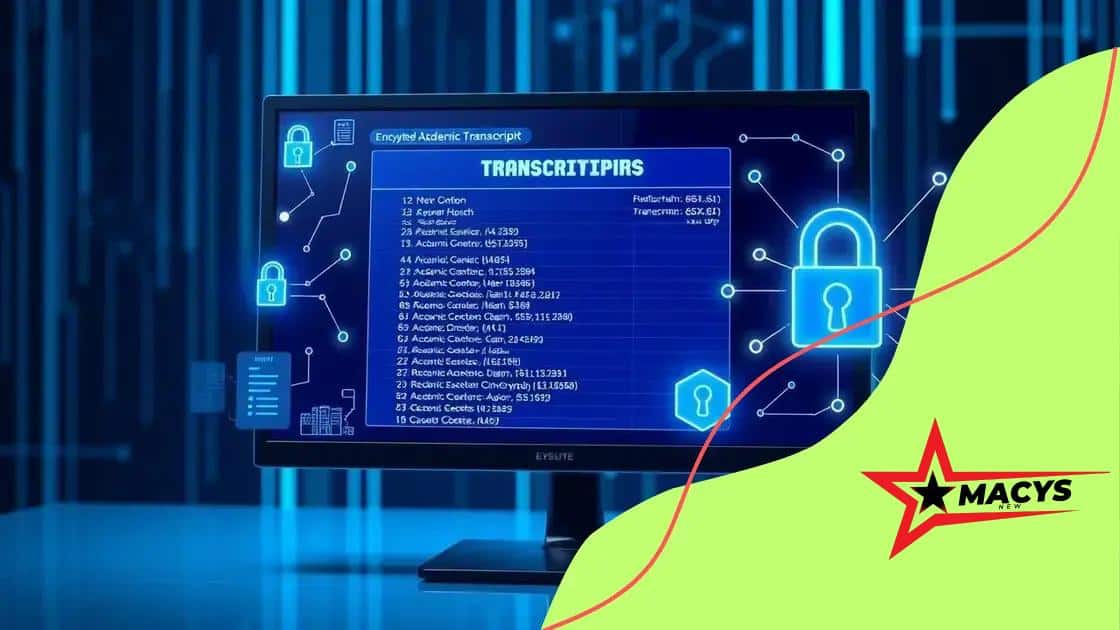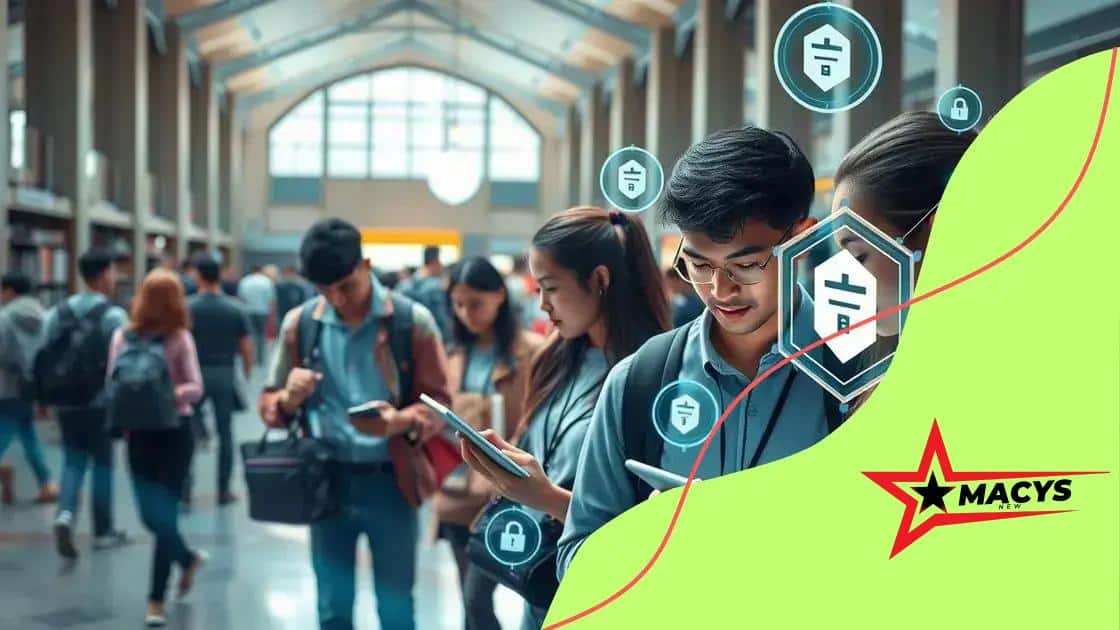Blockchain technology for academic record security

Blockchain technology for academic record security enhances the safety, efficiency, and verifiability of educational credentials while addressing challenges like data privacy and integration with existing systems.
Blockchain technology for academic record security is reshaping how educational credentials are managed. But have you thought about how it could impact your academic journey?
Understanding blockchain technology
To grasp the concept of blockchain technology, one must first understand its basic principles. At its core, a blockchain is a distributed ledger that records transactions across many computers.
This technology is decentralized, meaning no single entity controls it. Transactions are grouped together into blocks and linked in a chronological order, which creates a chain. This process ensures that once a transaction is recorded, it cannot be altered or deleted, which is crucial for maintaining trust and integrity.
Key Features of Blockchain Technology
There are several key features that set blockchain technology apart:
- Transparency: All participants can view the entire chain of transactions.
- Security: Transactions are secured using cryptographic hash functions, making them nearly impossible to tamper with.
- Immutability: Once a block is added, it is very difficult to change its contents.
- Decentralization: No single point of failure exists since the system operates on a network of computers.
Understanding these features illuminates how blockchain can enhance security, especially in contexts like academic records. For example, implementing blockchain technology for academic record security means that records are not only secure but also easily verifiable.
Additionally, every transaction involved in updating an academic record is time-stamped and accessible to authorized users. This ensures that both students and institutions can trust the validity of the records. Moreover, blockchain can simplify the verification process for employers and other institutions, reducing time and costs associated with background checks.
One interesting aspect of blockchain technology is its potential for smart contracts. These are self-executing contracts with the terms directly written into code. In the education sector, this could automate the process of issuing diplomas and certificates, ensuring they are always authentic and up-to-date.
How blockchain ensures record security
Blockchain technology is revolutionizing the way we think about security, especially concerning records. The unique characteristics of blockchain provide an effective solution for ensuring the security of sensitive data.
First, it’s essential to recognize that information stored on a blockchain is immutable, meaning it cannot be changed once it has been verified and recorded. Each block in the chain contains a unique cryptographic hash of the previous block, linking them together securely. This means that altering any information in one block would require changes to all subsequent blocks, making tampering extremely difficult.
Key Mechanisms That Enhance Security
The mechanisms behind blockchain security include:
- Decentralization: Unlike traditional databases, which are often stored in a single location, blockchain data is distributed across a network of computers. This reduces the risk of data loss or alteration.
- Encryption: Each transaction is encrypted with complex algorithms, which provides an additional layer of protection. This ensures that only authorized users can access specific data.
- Consensus Protocols: Before a new block is added to the blockchain, it must be verified by a majority of nodes in the network. This collective agreement ensures that all participants agree on the validity of the transactions.
In academic environments, these same principles apply. When a university issues a diploma through a blockchain system, the record is securely linked to prior transactions. This guarantees authenticity and prevents unauthorized changes. Students, employers, and institutions can trust the records because they are securely stored and verified by a network of peers.
Moreover, blockchain can create a seamless and transparent process for accessing records. Instead of lengthy verifications that can take days, a blockchain record can be verified in mere minutes, saving time and resources.
In conclusion, understanding how blockchain ensures record security is essential for appreciating its potential in various fields, especially academia. Its unique features provide a robust framework for protecting sensitive information, offering a level of security that traditional systems simply cannot match.
Advantages of blockchain in academia

The use of blockchain technology in academia comes with several significant advantages that can transform how educational institutions manage records. By leveraging this innovative technology, universities and colleges can enhance security, accessibility, and efficiency.
One of the primary benefits is the increased security of academic records. Since blockchain operates on a decentralized network, it protects information from unauthorized access and tampering. This is particularly important for diplomas and transcripts, as any alteration can lead to serious implications for students and institutions alike.
Improved Efficiency and Speed
Another advantage is the streamlined process of verifying credentials. In traditional systems, verifying a student’s academic background can take days or even weeks. With blockchain, this process can be expedited, allowing employers and educational institutions to get real-time access to verified records.
- Instant Verification: Employers can easily verify a candidate’s qualifications.
- Reduced Costs: Organizations can save money by minimizing the time spent on manual verifications.
- Secure Sharing: Students can control who accesses their records, enhancing privacy.
Moreover, blockchain technology offers transparency in academic processes. Each transaction related to record-keeping is logged and visible to authorized parties. This transparency can increase trust in educational credentials and promote accountability within institutions.
Additionally, it enables the concept of lifelong learning. As students continue to take courses and earn certifications, their records can be updated on the blockchain, creating an ongoing digital portfolio. This means that their achievements are always accessible and verifiable.
Overall, the advantages of blockchain in academia create a more secure, efficient, and transparent system for managing academic records. Institutions that embrace this technology can significantly improve their operations and foster trust among students and employers.
Real-world applications of blockchain for transcripts
The real-world applications of blockchain technology for transcripts are transforming how academic records are issued and verified. By implementing blockchain, educational institutions can create a secure, efficient system for managing student transcripts.
One significant application is the creation of digital diplomas and certificates that are directly linked to a student’s blockchain record. This ensures that the document is authentic and can be easily verified by employers or other educational institutions. No longer do graduates need to worry about fraudulent copies of their transcripts.
Enhanced Verification Process
An important feature of using blockchain for transcripts is the enhanced verification process. Employers and other institutions can verify a candidate’s academic achievements in real-time, drastically reducing the time and resources spent on background checks.
- Immediate access: Records are available at any time, allowing for quick verification.
- Trustworthy data: The information is immutable, meaning it cannot be altered or tampered with.
- Cost-efficient: Reduced administrative expenses by eliminating the need for extensive manual verification processes.
Another noteworthy application is the ability to track a student’s academic journey over time. With blockchain, every course taken, grade received, and credential earned can be recorded in one secure location. This creates a comprehensive digital portfolio for each student, showcasing their learning history.
Blockchain also allows for partnerships between institutions. For instance, if a student takes courses at multiple universities, those transcripts can be linked together on the blockchain. This interconnected system enhances collaboration among schools and provides students with greater flexibility in their educational experiences.
Overall, the real-world applications of blockchain for transcripts offer exciting possibilities. The technology is not only improving security and efficiency but also paving the way for a more collaborative and accessible educational landscape.
Challenges in implementing blockchain in education
Despite the significant potential of blockchain technology in education, there are several challenges to its implementation that institutions must navigate. Understanding these challenges is critical for successfully integrating this technology into educational systems.
One major obstacle is the lack of understanding and awareness of how blockchain works. Many educators and administrators may be unfamiliar with the technology and its benefits. This could result in resistance to change or hesitation to invest in blockchain solutions.
Technological Barriers
Another challenge is the technological infrastructure needed to support blockchain. Educational institutions often operate with legacy systems that may not easily integrate with new technology. Transitioning to a blockchain system requires significant upgrades or replacements of existing systems, which can be costly and time-consuming.
- Integration Issues: Current database systems may not be compatible with blockchain technology.
- Costs: Initial setup costs for blockchain can be high.
- Scalability: Institutions need to consider whether the blockchain can handle a growing number of transactions as more users adopt the system.
Furthermore, data privacy and security concerns arise when implementing blockchain. While blockchain provides enhanced security, it also raises questions about how student data is stored and accessed. Ensuring that sensitive information is kept confidential while still being accessible for verification is a complex balancing act.
Lastly, regulatory and compliance issues may hinder the adoption of blockchain in education. Educational institutions must navigate varying laws and regulations concerning data sharing and student privacy. This can complicate the implementation process, as institutions need to ensure they remain compliant with local and national guidelines.
Overall, while blockchain technology offers many advantages for education, these challenges must be addressed. Institutions that are proactive about understanding and overcoming these barriers can successfully leverage blockchain to enhance their educational records system.
The implementation of blockchain technology in education holds great promise for improving record security and verification processes. However, institutions must face several challenges, including the understanding of this technology, technological infrastructure, data privacy, and regulatory compliance. By proactively addressing these issues, schools and universities can successfully harness the benefits of blockchain to enhance their academic systems. This transformation not only provides improved security but also streamlines access to academic records, making education more accessible and trustworthy for students and employers alike. Embracing these innovations will be key to adapting to the future of academic excellence and integrity.
FAQ – Frequently Asked Questions about Blockchain Technology in Education
What are the main benefits of using blockchain in education?
Blockchain enhances security for academic records, allows for real-time verification, and reduces the costs associated with manual credential checks.
What challenges do institutions face when implementing blockchain technology?
Institutions may struggle with understanding the technology, integrating it with existing systems, and addressing data privacy and regulatory concerns.
How does blockchain improve the verification process for academic credentials?
It provides an immutable record of achievements, enabling employers and institutions to verify credentials quickly and securely.
Can blockchain help protect student privacy?
Yes, blockchain can store student data securely, ensuring it remains confidential while allowing authorized access for verification purposes.





